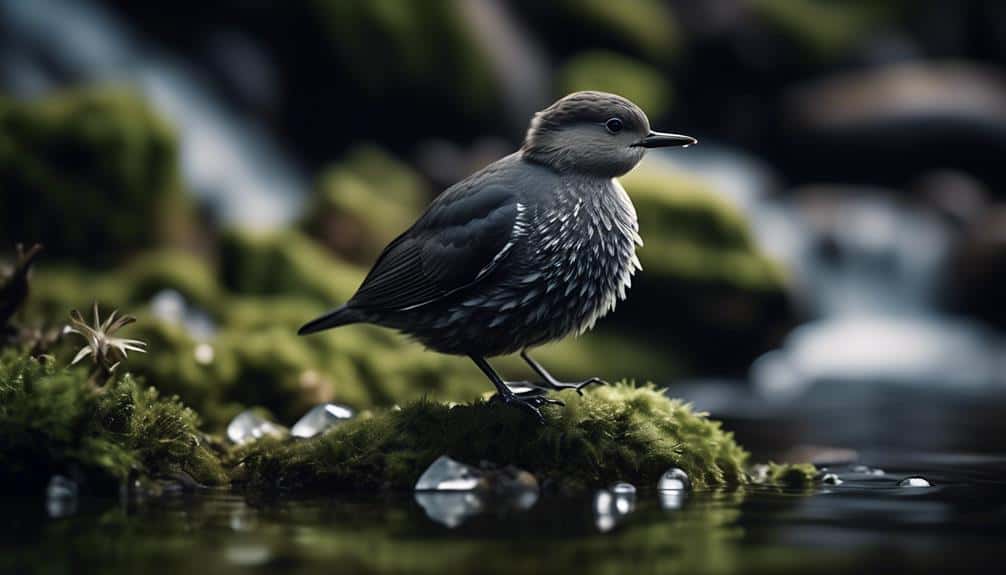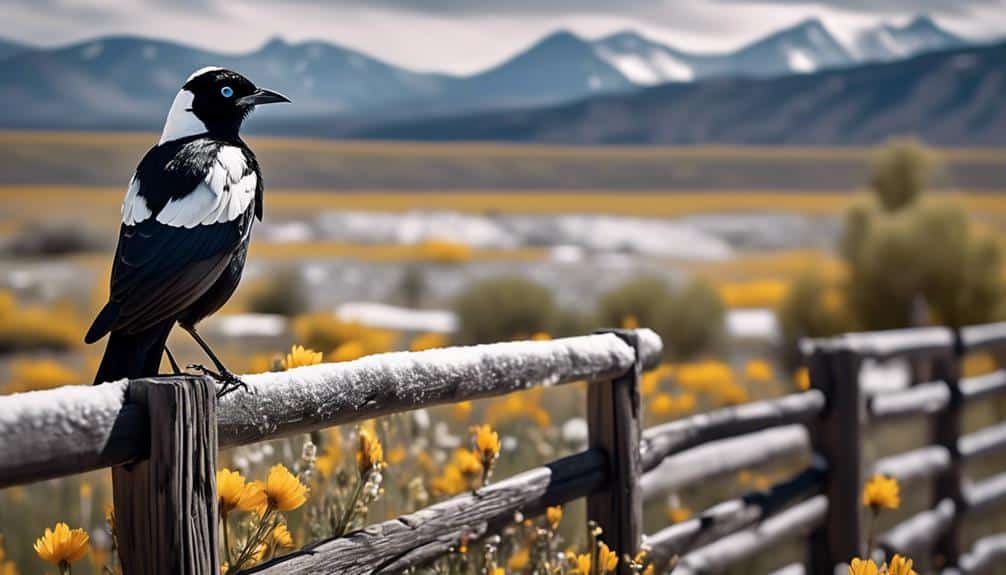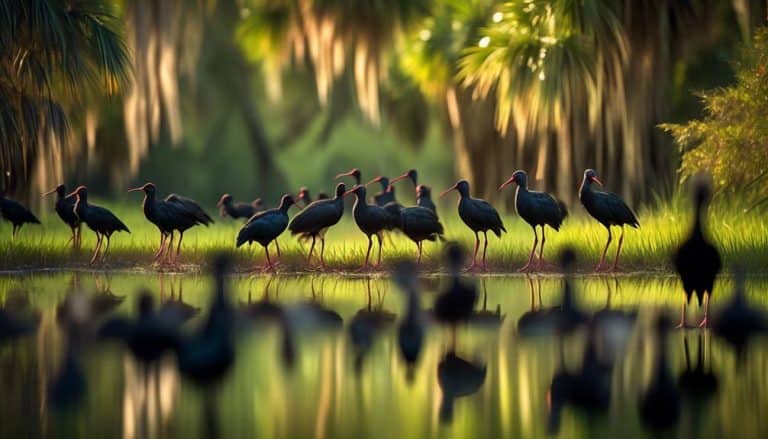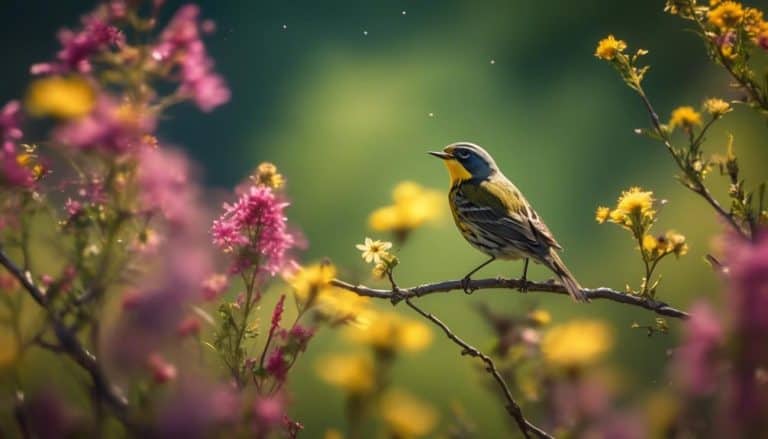As I stand here, my eyes scanning the vast Colorado landscape, I am reminded of a piano keyboard, its black and white keys stretching out across the horizon.
It is in this beautiful state that a variety of black and white birds call home, each one with its own unique charm and grace. From the majestic American Dipper, gracefully diving into the cool mountain streams, to the charismatic Magpie, with its bold and striking plumage, these birds captivate both birdwatchers and casual observers alike.
But that's not all, there are even more intriguing species to discover. So, let's journey together into the world of black and white birds in Colorado and uncover the wonders that await.
The American Dipper: A Colorado Waterbird

The American Dipper, also known as Cinclus mexicanus, is a fascinating waterbird that can be found in various waterways throughout Colorado. This small, black and white bird possesses unique adaptations for underwater foraging, making it well-suited for its aquatic lifestyle.
One of its most remarkable adaptations is its ability to dive and move along the riverbed, searching for food. The American Dipper has a dense plumage that provides insulation and buoyancy, allowing it to withstand the cold water temperatures and navigate swiftly underwater. Its wings are short and strong, enabling it to maneuver effectively in fast-moving streams.
In addition to its interesting foraging techniques, the American Dipper also plays a crucial role as a bioindicator for water quality in Colorado rivers and streams. Due to its reliance on clean water for its survival, this bird is highly sensitive to pollution and changes in water quality.
The Charismatic Magpie of Colorado

A remarkable and highly adaptive bird species that can be found in Colorado is the charismatic Magpie. Magpies, scientifically known as Pica hudsonia, are members of the crow family and are known for their striking black and white plumage, long tail feathers, and distinctive vocalizations. These intelligent and resourceful birds display fascinating behavior and nesting habits in Colorado.
Magpies in Colorado are known to be highly social and often form large, noisy groups called 'parliaments.' They're opportunistic feeders and have a diverse diet that includes insects, small mammals, fruits, seeds, and carrion. Magpies are also known to cache food items for later consumption, often burying them in the ground.
When it comes to nesting, magpies in Colorado are known for their elaborate and sturdy nests. They typically build their nests in trees or shrubs, using twigs, grass, and mud. The nests are often large and domed, providing protection for the eggs and young birds. Magpies are monogamous and both parents take part in incubating the eggs and raising the chicks.
The impact of urbanization on magpie populations in Colorado is a topic of concern. As urban areas expand, natural habitats are being destroyed or fragmented. This can lead to a decrease in suitable nesting sites and a reduction in food availability for magpies. However, magpies have shown a remarkable ability to adapt to urban environments, taking advantage of human-made structures and scavenging food from urban areas.
The Elegant Black-capped Chickadee

As we shift our focus to the elegant Black-capped Chickadee, it's worth noting the contrasting yet equally captivating characteristics of this species compared to the charismatic Magpie.
The Black-capped Chickadee, with its sleek black cap and bib, stands out against its white cheeks and belly. Its small size and agile flight make it a delightful sight to behold in the Colorado wilderness.
- Chickadee behavior:
- These birds are known for their friendly and curious nature, often approaching humans without fear.
- They've a wide range of vocalizations, including their distinctive 'chick-a-dee-dee-dee' call that helps them communicate with their flock.
- Black-capped Chickadees are skilled foragers, adept at finding insects, seeds, and berries in their habitat.
- Chickadee nesting habits:
- These birds prefer to build their nests in tree cavities or birdhouses, lined with soft materials like moss, fur, or feathers.
- They excavate their own nest holes or use existing ones abandoned by woodpeckers.
- Black-capped Chickadees are cavity-nesters, meaning they rely on tree hollows for shelter and protection during the nesting season.
The Black-capped Chickadee's behavior and nesting habits showcase its adaptability and resourcefulness. These charming birds bring a sense of liveliness and joy to Colorado's forests, enchanting both birdwatchers and nature enthusiasts alike.
The Striking White-breasted Nuthatch

With its distinctive black cap and striking white belly, the White-breasted Nuthatch is a captivating bird found in Colorado. This small songbird belongs to the family Sittidae and is known for its unique habits and foraging behavior. The White-breasted Nuthatch is a frequent visitor to backyard bird feeders, where it can be observed clinging to tree trunks and branches, moving head-first downwards as it searches for insects and seeds.
Nesting Habits
White-breasted Nuthatches build their nests in tree cavities, using materials such as bark, grass, and feathers to create a cozy and secure environment for their young. They are known to excavate their own nest holes or utilize existing cavities, sometimes even taking over abandoned woodpecker nests. These resourceful birds line their nests with soft materials to provide insulation and protection for their eggs and nestlings.
Diet and Foraging Behavior
The diet of the White-breasted Nuthatch consists mainly of insects, seeds, and nuts. They have a unique foraging behavior, often using their strong bills to pry open seeds and nuts while holding them firmly with their feet. This bird's foraging technique allows it to access hidden food sources that other birds may not be able to reach. The White-breasted Nuthatch is also known to store food for later consumption, hiding it in tree crevices or under loose bark.
The following table summarizes some key characteristics and behaviors of the White-breasted Nuthatch:
| Characteristic | Description |
|---|---|
| Size | 4.5 – 5.5 inches (11 – 14 cm) in length |
| Wingspan | 7.5 – 9.5 inches (19 – 24 cm) |
| Habitat | Deciduous and mixed forests, woodlands, parks, and suburban areas |
| Breeding Season | April to July |
| Average Lifespan | Up to 9 years |
The Adorable Mountain Chickadee

The Mountain Chickadee, a small and charismatic bird species, is a common resident of the Colorado mountains. With its distinctive black cap, white cheeks, and grayish-brown body, this adorable bird is a delight to observe in its natural habitat.
The vocalization behavior of mountain chickadees is particularly fascinating. They have a varied repertoire of songs and calls, including a distinctive 'chick-a-dee-dee-dee' call that gives them their name. These vocalizations serve various purposes, such as communicating with other members of their flock, establishing territory, and warning of potential predators.
When it comes to nesting habits and habitat preferences, mountain chickadees are quite selective. They typically choose tree cavities or nest boxes as their nesting sites, often excavating their own cavities or using abandoned woodpecker holes. These birds prefer coniferous forests, especially those with a mix of mature and young trees, as they provide ample sources of food and suitable nesting sites. They also have a preference for higher elevations, often found at altitudes above 9,000 feet.
The availability of insects, seeds, and berries in these habitats ensures a steady food supply for the mountain chickadees throughout the year.
The Rare and Elusive Black Rosy-Finch

Nestled among the picturesque Colorado mountains, the black rosy-finch stands as a rare and elusive avian treasure, captivating birdwatchers with its enigmatic presence. This exquisite bird, scientifically known as Leucosticte atrata, is a member of the finch family and is renowned for its unique coloration and habitat preferences.
The rarity of the black rosy-finch adds to its allure. With a population estimated to be less than 5,000 individuals, this species is considered a conservation priority in Colorado. Its limited distribution and specific habitat requirements contribute to its scarcity. The black rosy-finch is found primarily in alpine and subalpine regions, favoring rocky slopes, cliffs, and talus fields. These habitats provide the perfect blend of protection and food sources for the finch.
In summer, the black rosy-finch can be observed at higher elevations, typically above tree line, where the weather is cooler and more suitable for breeding. During this time, it feeds on insects, spiders, and seeds. In winter, it descends to lower elevations, seeking out areas with abundant food sources such as weed seeds and berries.
The black rosy-finch's habitat preferences are closely tied to its survival and reproductive success. As such, conservation efforts focused on preserving and restoring its preferred habitats are crucial for the long-term viability of this rare and elusive species.
Frequently Asked Questions
What Is the Average Lifespan of Black and White Birds in Colorado?
The average lifespan of black and white birds in Colorado can vary based on factors such as habitat, diet, and predation. Additionally, different species may have different average lifespans.
How Do Black and White Birds in Colorado Survive the Harsh Winters?
During the harsh winters in Colorado, black and white birds exhibit remarkable adaptations to ensure their survival. They employ various strategies such as finding shelter, conserving energy, and relying on food sources that are available during this challenging season.
Are There Any Specific Threats or Predators That Black and White Birds in Colorado Face?
There are several threats and predators that black and white birds in Colorado face. Understanding predator-prey dynamics is crucial for conservation efforts aimed at protecting these birds and their habitats.
Do Black and White Birds in Colorado Migrate to Other Regions During Certain Times of the Year?
Yes, black and white birds in Colorado do migrate to other regions during certain times of the year. Their migration patterns are influenced by breeding habits and environmental factors such as food availability.
Are There Any Unique Behaviors or Mating Rituals Associated With Black and White Birds in Colorado?
There are unique courtship behaviors and breeding habitats associated with black and white birds in Colorado. These behaviors and habitats play a crucial role in their mating rituals and ensure successful reproduction.
Conclusion
In conclusion, the black and white birds of Colorado showcase the incredible diversity and beauty of avian life in the region.
One fascinating statistic that highlights this is that Colorado is home to over 475 bird species, including numerous black and white species.
This astonishing number underscores the importance of preserving the habitats and ecosystems that support these birds, ensuring that future generations can continue to marvel at their elegance and charm.







